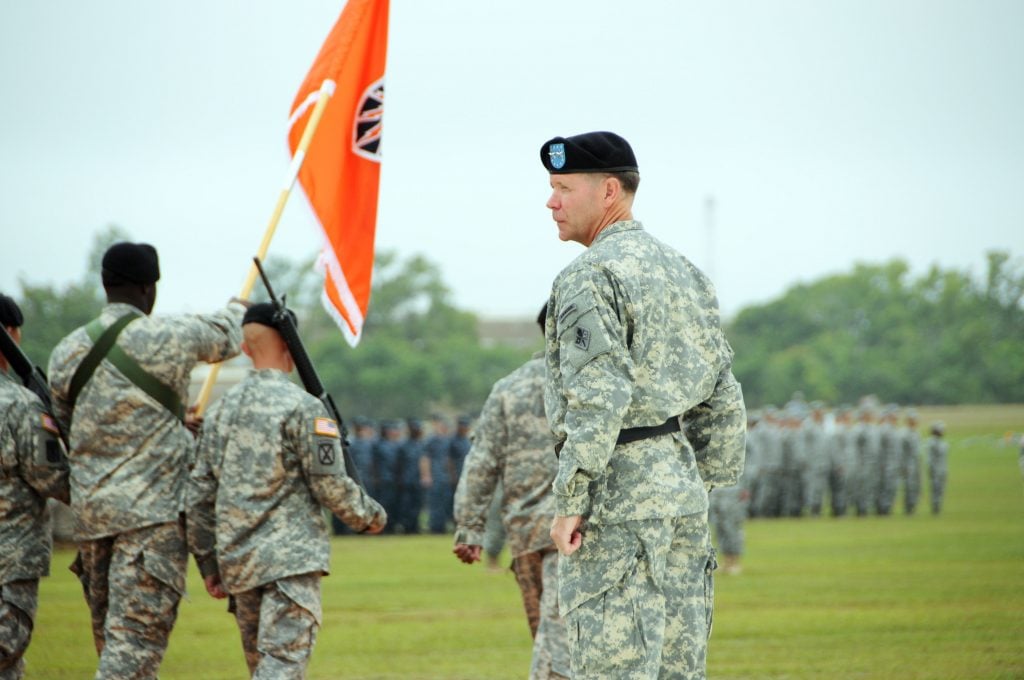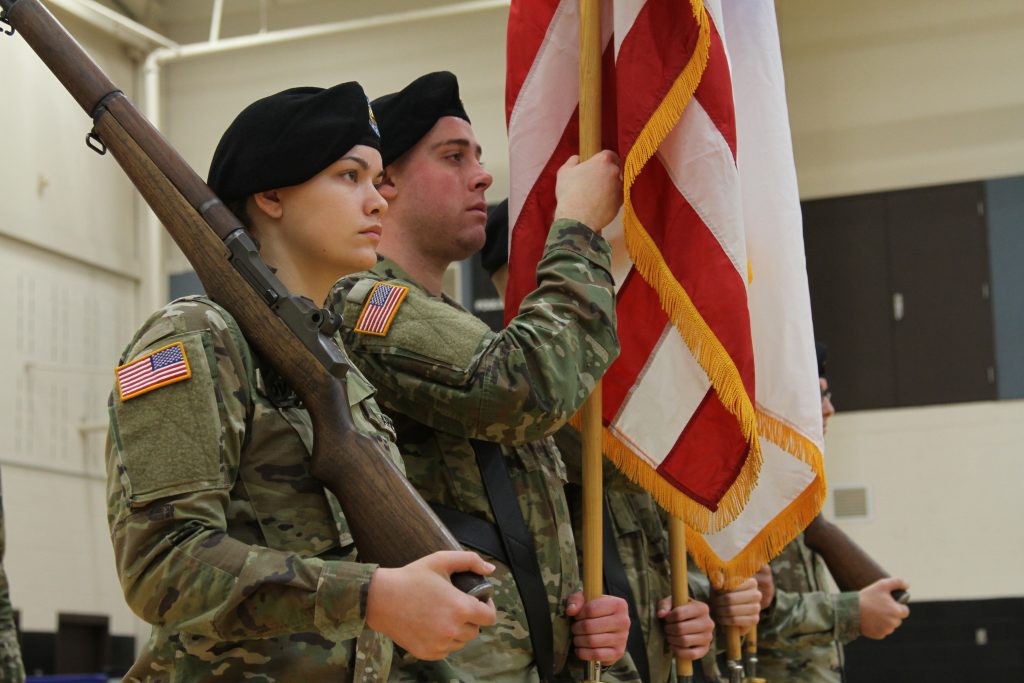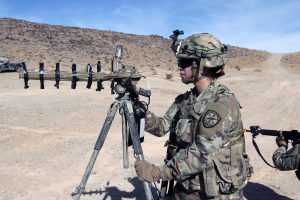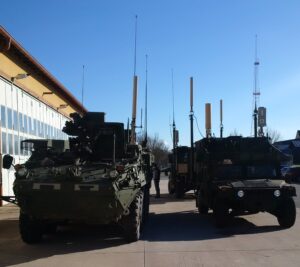By SYDNEY J. FREEDBERG JR
 The Army is already struggling to man its new cyber units -- and now it wants to expand their ranks and responsibilities for a new mission.
The Army is already struggling to man its new cyber units -- and now it wants to expand their ranks and responsibilities for a new mission.
Lt. Gen. (then Maj. Gen.) Stephen Fogarty reviews the troops on taking command of the Army Cyber Center at Fort Gordon.
TECHNET AUGUSTA: The three-star chief of Army Cyber Command wants new online counter-propaganda capabilities at every level, from his own East Coast HQ down to frontline combat brigades.
Lt. Gen. Stephen Fogarty is now finalizing an ambitious and risky proposal to put before top Army leaders: take the service’s nascent cyber and electronic warfare force — a cadre of hackers and jammers that is itself still under construction — and expand it to take on the wider world of information warfare.
“We started with cyber,” Fogarty said. “We found out pretty quickly we needed to add EW [Electronic Warfare]. Now we really understand we’ve got to get IO [Information Operations] and IW [Information Warfare] into the mix. So, let’s start,” he said.
Fogarty and his staff spoke to me at length over the last two days to explain their draft proposal. They were also at pains to emphasize this is a work in progress. What we describe below is definitely not Army Cyber Command’s final proposal. Once that proposal is finalized, it must still run a gauntlet of hard-nosed four-stars before the Army Secretary and the Chief of Staff give the thumbs-up or thumbs-down.
That said, the fact that Fogarty was willing to announce this plan in public here at the AFCEA TechNet Augusta conference, let alone share so many details with a reporter, strongly suggest he’s pretty confident his superiors will be receptive. No less a figure than the four-star chief of Training & Doctrine Command, Gen. Paul Funk, kicked off the conference with strong words about the urgent need to improve Army information warfare. Funk, one of the service’s top four commanders, set the stage — literally, the same exact stage — for Fogarty’s announcement that same day.
For a half century, DRS has provided military forces around the world with advanced technologies and capabilities to meet their mission needs. Here are some highlights.
From LEONARDO DRS
Yes, the final details will probably be different. Indeed, the Army’s new modernization strategy is all about rapid-fire trial and error. Instead of the approach that spent years refining requirements on paper and technologies in the lab — and often failed — the new approach is to field-test prototype technologies and experimental units ASAP, getting real-world feedback and make changes before building anything in bulk. Whatever Fogarty formally proposes this fall, and whatever top leaders subsequently approve, it will evolve further over the next 10 years.
That’s not a problem: That’s the plan.
 “If we waited for normal Army processes, it could take us years” of PowerPoint slides and abstract arguments to get a force into the field, Fogarty told me. Under the new high-speed strategy, he said, “for us the big idea is to get them out there, get them operating.”
“If we waited for normal Army processes, it could take us years” of PowerPoint slides and abstract arguments to get a force into the field, Fogarty told me. Under the new high-speed strategy, he said, “for us the big idea is to get them out there, get them operating.”
Army cyber/EW troops with laptop and guns at the National Training Center on Fort Irwin, Cali.
Leveling Up
This time last year, Lt. Gen. Fogarty publicly floated the idea that Army Cyber Command might soon expand into an Information Warfare Command. This week, 12 months of intensive studies later, Fogarty said he plans to formally submit that proposal to his superiors in the next 60 days. But a renamed ARCYBER just the tip of the iceberg of the new force structure.
So let’s start at the brigade combat team, which remains the fundamental building block of the modern Army. Not coincidentally, Fogarty noted, the brigade is the lowest level headquarters with access to the Intelligence Community’s global intranet for top secret/sensitive compartmented information, JWICS. Without that access, it’d be difficult to figure out who’s really behind a particular disinformation campaign or what response the Army’s own messages were getting.
An Army cyber/EW soldier sets up an antenna during exercises at the National Training Center on Fort Irwin, Calif.
The Army has already started creating Cyber/Electromagnetic Activity planning cells in its brigades. Now Fogarty wants to evolve those CEMA cells — which are still growing themselves — into Information Warfare cells. At the brigade level, that doesn’t mean additional personnel, at least not for now. But the Army’s cyber school at Fort Gordon, Ga. — which already added electronic warfare to its curriculum — will train cyber/EW troops (MOS series 17) to also do some information operations.
Those info ops will be limited in scope, Fogarty said. “That brigade commander is probably not going to take down national infrastructure,” he told me. “He’s worried about the population that’s in his area of operations, the adversary forces that are in that area of operations.” A typical operation might be shutting down an extremist website or jamming a radio station that’s advocating violence.
At echelons above brigade, where the scope of action is much larger, the planning cells will gain one or more dedicated Information Operations Officers. (Those scarce specialists are classified as Functional Area 30 and trained not at Fort Gordon but at Leavenworth). The exact details are not for public release and still in flux in any case, but a division will have more staff in its IW cell than a brigade, a corps will have more than a division, and a theater-level Army Service Component Commands (ASCCs) will have more than a corps.
Fogarty also believes his information warriors will be hungry for more intelligence than current structures can provide, so he’s pushing to grow the intel force as well. To start with, ARCYBER will propose to the Army’s deputy chief of staff for intelligence (G-2) to create a new unit at the theater level, to be called either a Cyberspace Operations Military Intelligence Group or Brigade. (The precise name and size are still in discussion). The new intel unit would combine regular active-duty, Reserve, and National Guard troops.
If the proposal is accepted, the Army would probably create a single one of these new theater-level intelligence units as a prototype. Which Combatant Command would get it first is, again, to be determined. Based on that real-world trial, the Army would then refine the design and confirm it really works before creating more such units for other COCOMs.
Army Cyber is also working with military intelligence on whether other new intel units might be needed. ARCYBER is also collaborating with Army Special Operations, which runs psychological operations (formally known as Military Information Support Operations, MISO).
At the top of the hierarchy, Army Cyber Command — which has worldwide responsibilities — will become the Army Information Warfare Command. It’ll also move from its current home at Fort Belvoir, just south of Washington, DC, to Fort Gordon this coming June. Its new headquarters building at Gordon is already complete, Fogarty told the conference. The network — the command’s key weapons system — is being installed, and a new Information Warfare Operations Center is being put together.
 But a unit without people is just paper. Where are is the Army going to find all these highly skilled, technically expert soldiers?
But a unit without people is just paper. Where are is the Army going to find all these highly skilled, technically expert soldiers?
An Army color guard stands at attention during the activation of the I2CEWS battalion on Jan. 11.
Growing The Force
The independent Government Accountability Office recently warned that the Army may be creating new cyber units faster than it can man them. As of March — the latest data publicly available — one elite battalion, the I2CEWS detachment in Pacific Command, had only 55 percent of its planned personnel, while another, ARCYBER’s Cyber Warfare Support Battalion, had only 18 percent.
That’s a conscious choice by the Army to move quickly, Fogarty and other officials said here. The service is still figuring out the full range of missions these units will do, let alone what skillsets they’ll need to do them. The strategy is to get a minimum force in the field as fast as possible to figure that out in live experiments and exercises. Even if the Army could fill all the positions in the new organizations overnight, it would be premature to do so when the org chart is going to change.
What about the high-tech equipment these highly skilled soldiers will use? It turns out an information warfare forces largely fights with laptops.
Army 8×8 Stryker (left) and Humvees (right), all mounting variants of the hastily fielded Saber Fury electronic warfare system — note the veritable forest of antennas.
“We’re at an acceptable level of risk, [because] we’re not an equipment-intensive organization,” Fogarty told me.
Yes, the Army is still rushing to field planning software and long-range jammers so its rapidly growing electronic warfare corps actually has equipment to use. (A running joke is that “EW” stood for “extra worker” since those troops had nothing to do). But in cyber and information operations, the primary weapon is software — and the main expense is not equipment, but people.
“We’ll generate those soldiers over a period of time,” Fogarty told me. When the Army’s cyber training program started up at Fort Gordon in 2015, it graduated just 15 soldiers in its first class, 30 in the first year. This year, it graduated 1,500 and plans to grow to over 2,000 next year.
That’s still a fraction of the 15,000 new Signal Corps soldiers — from radio operators to network administrators — that graduate from Fort Gordon every year, Fogarty said, but it’s still dramatic growth.
“We’re not going to build this overnight,” Fogarty underlined. Nor does he need to. The Army has given itself until 2028 to make the entire force, as opposed to just selected units, fully capable of what it calls Multi-Domain Operations across land, sea, air, space, and cyberspace.
“We’ll build as fast as we can…with the idea [that] 2028 is really when we’ve got to be fully set,” he told me. Starting right now, he said, “we’ve got to get the requirements out, we’ve got to get people, we’ve got to build support.”
“If we don’t,” he said, “then … by the time you need it, it’s too late.”


No comments:
Post a Comment